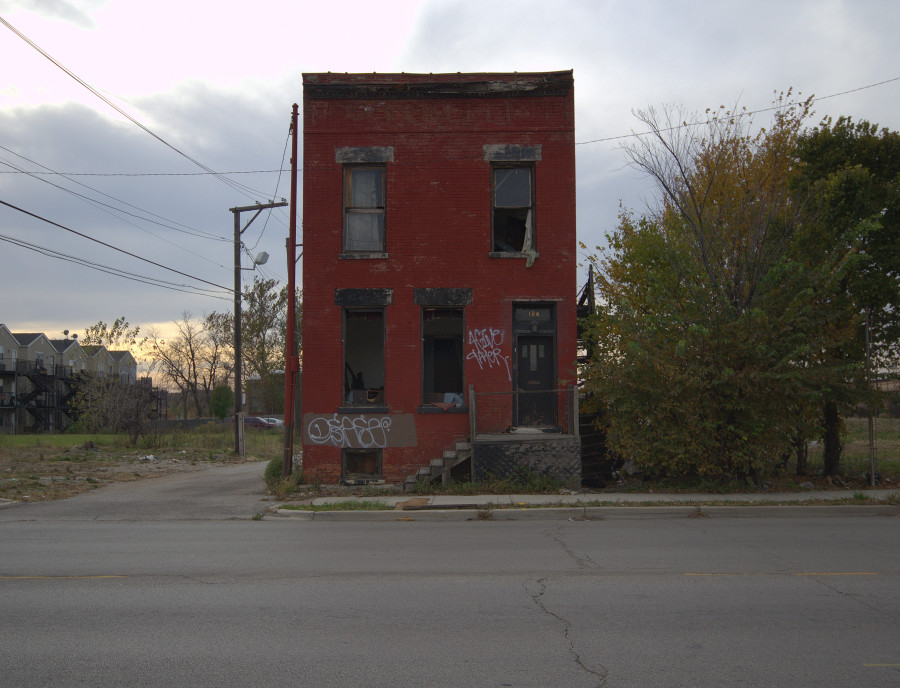Tribute: 124 North Sacramento Boulevard
For years, possibly decades, the two-story brick flat at 124 North Sacramento Boulevard, just south of once-bustling Lake Street, has stood isolated and surrounded by vacancy. Bordered by an alley to the south and an overgrown fenced lot to the north and existing here since approximately 1889, it provides a glimpse into the former life of this block, neighborhood, and the greater West Side of Chicago.
After being annexed as rural, open land to the city of Chicago in 1869, the area east of Garfield Park was not fully populated until the arrival of the Lake Street Elevated Railroad into downtown Chicago. When first opened for service in 1893, its western terminal was at California Avenue and then additional stations were built west every 2 – 4 blocks, starting next with Sacramento Boulevard, steps from 124 North Sacramento.

Coal-burning steam locomotive “Clarence A” on the Lake Street Elevated Railroad at Oakley Avenue, 1893 (courtesy of Internet Archive)
The neighborhood surrounding 124 North Sacramento Boulevard has radically transformed over the history of Chicago, as has most of the greater Garfield Park and West Side areas. It has suffered debilitating and unfair circumstances, such as depopulation including “white flight” and “blockbusting” tactics; systematic disinvestment in public infrastructure, transit, and commerce; widespread neglect and ensuing demolition of hundreds of buildings, including a devastating inventory of historically significant structures that once defined Garfield Park.

Intersection of West Lake Street and North Sacramento Boulevard: 1935 (top image, via UIC Digital Collections) and 2014 (bottom image, via Google Street View)
As seen in the top image (taken in 1935 for a survey of the Chicago Boulevards System) of this diptych, the Lake Street Elevated’s former Sacramento station is depicted in the center, clad in picturesque Queen Anne styling like other extant stations such as Ashland and Conservatory-Central Park. The former existence of nearby multi-story residential buildings is also documented here, which conveys the former residential density and infrastructure this area once supported. Various storefront businesses are indicated by awnings and signage like “groceries” seen on the right edge of the photograph.
The bottom image (taken in 2014) shows the vast open space and extreme vacancy left in the wake of the persistently deteriorating circumstances of the past 80 years. None of the structures remain in the 1935 image, except for rails: no transit station, no businesses, no homes. Poignantly, in the far left you see a public bus bench — ostensibly for the CTA’s #16 Lake Street route that was abandoned in 1997. It makes one wonder about the purpose of these “orphaned” benches: maybe to exist purely as ad space and a revenue source for public transit, while at the same time not providing or facilitating that very service in the community.
The following series of photographs were made on a weekly basis during a five-week period from October to November 2014. Each image records the changing facade of the 124 North Sacramento Boulevard in various stages of decay and external conditions.
In researching public records, it appears this building was owned as a single-family home by the same resident(s) for many years. In May 2014 it fell into foreclosure according to the Cook County Recorder of Deeds. A court petition from the City of Chicago to authorize demolition was then entered in August 2014, citing “junk and debris throughout the property in question.”
The city’s demolition permit for the building was issued November 18th, 2014 (via Chicago Cityscape), however wrecking and removal actually took place between November 4th – 7th as documented in the photographs above. As there is no replacement development planned to take place, the site of 124 North Sacramento Boulevard will most likely remain vacant for years to come.
References
- UIC Digital Collections (flickr)
- “Chicago’s mass transportation system”, Chicago Transit Authority (Internet Archive)
- Google Maps Street View, July 2014
Related Articles and Further Reading
- Get To Know An “L” Line: Lake Branch-Green Line
- A Victorian Greystone in East Garfield Park
- East Garfield Park Community Area (Chicago Architecture Data)










Why does the city seek to demolish every home that falls in disrepair? What do they think they are achieving? Do they have any idea that they are only setting these neighborhoods back further than they already are? The building profiled, like all the other that at one time surrounded it, could have been maintained in anticipation of a population upswing. We’ll never get a building like that back. We’ll just get schlock, because that’s how we build today.
Thanks for this. I had no idea of the former prominence of this corner. I drive by this address regularly and my wife and I often commented on this house as we passed. I’m glad you took the interest and satisfied mine. At least we haven’t lost as much as Detroit. It is truly a shame, scars of slavery and prejudice.
Wow my childhood home